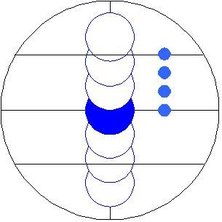I started with center ball and drew three overlapping tips going up and down to represent three increments of follow and draw, overlapping in a slightly different manner so you can see the overlaps clearly. As you can see, what is commonly called a “tip” is actually a half tip – that is, you move the center of your tip up or down to the edge of the previous tip’s location. If you do this three times from the center in any direction, you reach very close to the maximum you can hit without a miscue.
A few things are interesting about this. First, what I believe most people mean when they say 1 tip of english is actually a half tip. I believe that because most people I know, and most everything I’ve read, frequently talks about using 1, 2, or 3 tips of english, or somewhere in between. You can see from the diagram that it’s impossible to use 3 full tips of english, if everyone went by the physical definition we would be talking about using ½, 1, or 1 ½ tips, not 1, 2, or 3.
Another possible explanation is that they are referring to the contact patch between the tip and the cue ball. Regardless of tip location, the contact patch is roughly 3mm in diameter. If you look to the right of the center axis in the diagram, I’ve drawn these contact patch positions, and you can see that as you move up, and different parts of the tip are hitting different parts of the curvature of the cue ball, you get a nice progression of 1, 2, and 3 tip positions above or below center. They are not right next to each other, and in theory you could hit spots in between these, just like you can with the regular tip positions, but they give us good reference points to work from.
Speaking of which, when hitting maximum draw or follow (or side for that matter), you can see that the cue tip is 3 half tips above center, but it is actually making contact with the cue ball roughly half way between the center and edge of the cue ball. This is about the limit before the curvature of the cue ball prevents a solid hit, or in the case of draw before the table gets in the way. Since most striped balls are exactly that size, you can practice hitting with maximum spin by orientating the stripe either horizontally for draw/follow or vertically for side spin, and then aiming the inner edge of your tip at the outer edge of the stripe. If applying fresh chalk you often can also see the mark you left after the hit as well, as long as it’s not rubbed off by the table. You must learn to hit near these maximum limits to get that smooth “whipping” action on your cue ball with a minimum of force, or if you ever want to enter a trick shot competition… J
And finally, to dispel one last myth – while your tip shape (dime vs. nickel) might allow you to press the limits a bit more, or at least more than a poorly shaped tip, the size of the shaft doesn’t matter that much within normal limits. I’ve heard people say they get more english with a Predator Z2 shaft, or a similar thinner shaft. The difference between that 11.75mm shaft and my example shaft of 12.7mm is 1 mm. Which means that for each half tip progression, the tip location is .5mm lower. After 3 half tips, I would be 1.5mm further from the edge than with my sample drawing. So yes I could move slightly more toward the edge with a thinner shaft in terms of “tips”, but the actual physical location of the edge of the tip in the maximum tip position for either shaft is achievable just the same. The difference with the smaller shafts is that visually they appear to be slightly less toward the outside of the ball, or more above the table on draw shots, which may give some people the confidence to venture more toward the edge of the ball.
So be aware of the possible confusion around this, and when someone tells you to use a tip of english make sure you know which tip size they mean!

